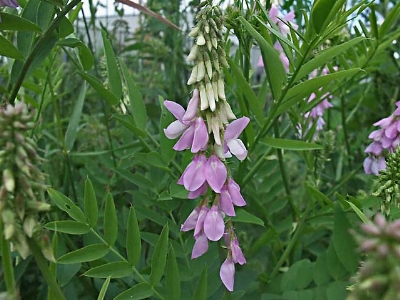- Its leaves are compound with lance-shaped ends, and the fruit consists of a round, indented pod containing many seeds.
- The flowers are white, lilac, light blue, or pinkish in color and grow on terminal spikes.
- These dried, above-ground parts, harvested during the summer flowering season, are the parts of the plant used medicinally.
- The plant has no scent unless bruised, when it emits a disagreeable odor, perhaps how the name “goat’s rue” originated. Goat’s rue should not be confused with “rue” (Ruta graveolens)
Contents
Uses
- Goat’s rue derivatives have been associated with reductions in blood sugar levels.
- Goat’s rue is also a well-known diuretic and increases breast milk production.
- Other effects include use as a tonic, liver-protectant, and as a platelet aggregation inhibitor.
- Digestive problems
Cautions
- Discontinue use if symptoms such as headache, jitteriness, or weakness occur.
- The safety of the plant has not been proven in pregnancy or breastfeeding.
- Goat’s rue may interfere with the absorption of iron and other minerals.
Interactions
- Possible interactions may exist with other hypoglycemic medications. Goat’s rue may interfere with absorption of iron and other minerals.
- Medications for diabetes (Antidiabetes drugs) interacts with GOAT’S RUE: Goat’s rue might decrease blood sugar. Diabetes medications are also used to lower blood sugar. Taking goat’s rue along with diabetes medications might cause your blood sugar to go too low. Monitor your blood sugar closely. The dose of your diabetes medication might need to be changed.
- Some medications used for diabetes include glimepiride (Amaryl), glyburide (DiaBeta, Glynase PresTab, Micronase), insulin, pioglitazone (Actos), rosiglitazone (Avandia), chlorpropamide (Diabinese), glipizide (Glucotrol), tolbutamide (Orinase), and others.
Other Names
Faux-Indigo, French Honeysuckle, French Lilac, Galega, Galéga, Galéga Officinal, Galega bicolor, Galega officinalis, Galega patula, Galegae Officinalis Herba, Geissrautenkraut, Goat’s Rue Herb, Italian Fitch, Lavanèse, Lilas d’Espagne, Lilas Français, Rue-de-Chèvre, Rue des Chèvres, Sainfoin d’Espagne.
References
- Source: Drugs.com, www.drugs.com/npp/goat-s-rue.html
- Source: WebMD, “Goat’s Rue”, www.webmd.com/vitamins-supplements/

